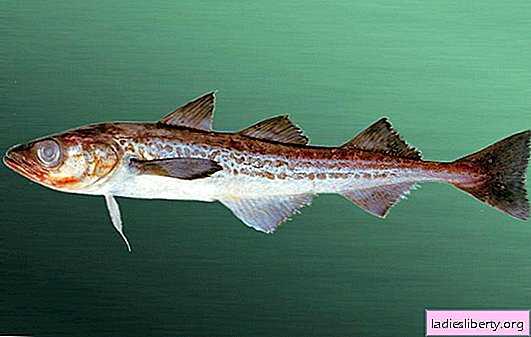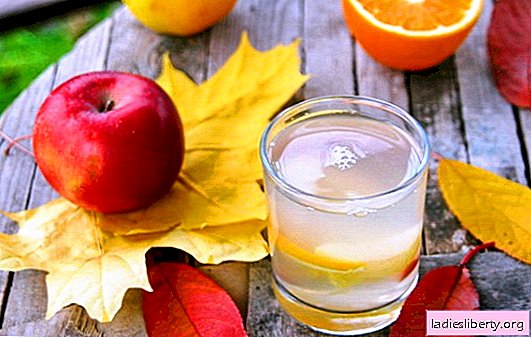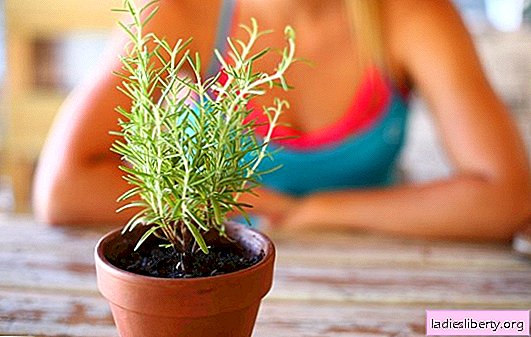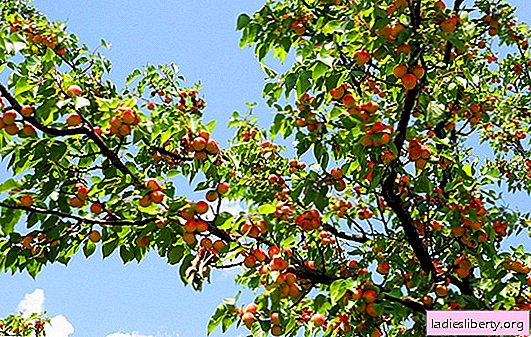
Pollock is a prominent representative of the Treskov family.
It lives in the waters of the Pacific and Atlantic oceans, where the bottom of its diet is bottom plankton, small crustaceans and young squids.
Fish rarely exceeds 45cm in length, and its weight can range from 250g to 500g.
But there were cases of catching a carcass with a weight of about 4 kg.
In many countries, pollock is the most used fish in food.
And this is not accidental, since it has long been noticed how the composition and useful properties of fish affect the state of the body.
Pollock: composition, as used
The mineral and vitamin composition of fish is surprising in its diversity. There is no doubt the benefits of fish to humans. Its composition can be safely called "royal." In many respects, it surpasses many valuable species of fish. Present:
• Vitamins: retinol (A) 0.01 mg, nicotinic acid (PP) 1.3 mg, thiamine (B1) 0.11 mg, riboflavin (B2) 0.11 mg, pyridoxine (B6) 0.1 mg, folic acid (B9) 4.9 μg, ascorbic acid (C) 0.5 μg, C (0.3 μg).
• Macronutrients: calcium (40 mg), sodium (40 mg), magnesium (55 mg), phosphorus (240 mg), chlorine (165 mg), potassium (420 mg), sulfur (170 mg).
• Trace elements: zinc (1.12mg), iron (0.8mg), copper (130mkg), iodine (150mkg), chromium (55mkg), copper (130mkg), fluorine (700mkg), chromium (55mkg), molybdenum (4mkg), nickel (7mkg), cobalt (15mkg).
• Acids:
- saturated: palmitic, myristic, stearic.
- polyunsaturated: omega-3, linolenic, arachidonic.
- monounsaturated: palmitoleic, oleic.
Pollock is a leader among marine fish in terms of iodine, selenium and protein.
The nutritional value:
• fat 0,9g;
• protein 15.9g;
• water 81.9gr;
• ash 1.3g;
• cholesterol 50mg.
Pollock has a low calorie content: in 100g of fresh fish there is only 72kcal. In boiled calorie content is slightly higher - 78 kcal, in steamed - 80 kcal, in baked - 79 kcal, in fried - 112 kcal. These indicators allow you to quickly get enough of it, but at the same time maintain normal weight. The regular presence of fish in the diet allows you to eat tasty and healthy, without harm to the figure.
In cooking, pollock has long been known. Fish in many countries is a part of national dishes. It is extremely tasty, easy and quick to prepare. The following products are prepared from fish:
• flour;
• fish: smoked, dried, dried;
• canned food;
• caviar;
• stuffing.
The nutritional value of the fish and its rich composition allows it to fry, stew, cook, bake. Pollock will be a good side dish for rice, vegetables. It makes delicious soups, main dishes, pies, cold appetizers, salads.
Pollock is used in cosmetology. It affects the condition of the skin, nails and hair. Dull hair, peeling on the skin, brittle nails are the consequences of a lack of fats, proteins and vitamins in the body. To eliminate these problems and make up for their deficiency, it is necessary to include pollock in the diet. Fish allows you to cope with these problems in a short time.
Compositions of anti-aging cosmetics are prepared from pollock roe and liver, since they affect the formation of collagen and increase antioxidant protection. Pollock gonadal extract is used in the production of regenerating cosmetic products.
Pollock is valued and is often used in medicine. It must be used for problems with vision, heart, thyroid, digestive organs, and diabetes. Fish successfully heals skin diseases, copes with viral, genitourinary, fungal infections.
It is recommended to include nutritionists in the diet for those who want to lose weight. But it’s important to remember that pollock is useful for losing weight only in boiled and stewed form. Avoid pollock fried and seasoned with sauces. Fish does not contribute to fat burning. The decrease in its volume is due to the fact that little energy is spent on the processing and assimilation of pollock. To ensure the life and health of the body, the decomposition of the fat layer under the skin occurs.
Pollock: benefits for the body
In our country, fish is not very popular in comparison with China, Korea, and Japan. But despite this, the benefits of pollock for the body are significant.
He will show all his useful properties if he is present in food at least 2 times a week. They are manifested in the following:
• fatty acids affect the heart muscles and blood vessels. They reduce the indicator of "bad" cholesterol, prevent the formation of cholesterol plaques, improve all metabolic processes, lead to a normal indicator of pressure.
• Proteins increase mental abilities, have a beneficial effect on overall well-being.
• Vitamin - mineral complex increases activity, improves mood and fills with energy, helps to resist infectious and viral diseases.
• Iodine affects the state of the thyroid gland and prevents the development of pathological changes in it.
• Selenium helps to neutralize toxic substances, removes excess salt, waste and toxins.
• Fat normalizes the functioning of the digestive system, ensures proper digestion and assimilation of food.
• Cobalt takes part in the process of hematopoiesis, in carbohydrate metabolism.
• Normalizes sugar levels.
• Improves visual acuity and quality.
• Bone and tooth tissue is strengthened.
• The risk of malignant neoplasms is reduced.
• Cells and the body are protected from aging, the regeneration process in them is accelerated.
• Metabolic processes are regulated.
• Accelerates the healing of wounds and ulcers.
• Increases immunity.
• Improves the condition of tendons, ligaments.
Often it is pollock that doctors recommend to include in the nutrition of seriously ill people during the rehabilitation period, pregnant and lactating women, the elderly, and smokers.
For various psycho-emotional disorders, doctors advise including fish in the daily menu. The benefits of pollock are that its fatty acids and thyroxine work wonders: they calm the nervous system, relieve fatigue, strengthen nerve endings, improve blood circulation in the brain, and stabilize the patient's condition.
The absence of carbohydrates in the fish fillet makes it an indispensable dietary product.
Pollock is a universal fish. Benefits are not only fillets, but also pollock liver, caviar. They impress with their unique composition, useful and valuable properties.
Pollock: what is the harm to health
Pollock can be harmful. Its negative effect on a person is associated with the peculiarity of his body and with the amount used.
It is necessary to refuse to use it in any form if:
• there is an allergic reaction to any type of seafood;
• there is an individual intolerance to marine fish species;
• a person suffers from hypertension.
High salt concentration in pollock has a negative effect on blood pressure. Salt increases its performance. In addition, sea salt with frequent use of pollock damages the mucous membranes. If a person has gastritis or peptic ulcer, kidney and duodenal disease, then it is better to stew or boil the fish.
In pollock, as in all fish living on the bottom, harmful microorganisms are constantly located in the gills. Before starting to cook pollock, it should be cleaned well, thermally treated, and the head with gills should not be used at all.
The harm from fish can increase in case of violation of the terms and standards of storage. When buying it, you do not need to choose a fish that has repeatedly been frozen. It is easy to distinguish it - if the fish was frozen only once, then it
• will be smooth;
• without damage to the skin;
• fins will not stick out;
• a thin layer of ice will be present on the carcass;
• there should be no bloody stains on the ice;
• the fish will not be glued together;
• meat should be white, not gray or yellowish.
If we compare the health benefits and harms of pollock, the latter is negligible. Since fish is accessible to everyone, and its benefits are not inferior to many expensive species, pollock should be present in the diet of every person at least once a week.
Pollock for children: useful or harmful
The first fish in the baby's diet should appear by 9 months. Pediatricians are advised to start complementary foods with low-fat marine fish species: hake, zander and pollock. Pollock is better than other fish for the first acquaintance of a child with fish. Firstly, the fish is not allergenic, and secondly, the growing body of the child constantly needs vitamins, minerals, and pollock will help to get them in the right amount.
At the first feeding, the baby can be given no more than 0.5 hours of fillet. Gradually, a single dose increases to 50g. It is important to remember two rules:
1. Fish should be introduced only after meat.
2. You can not give the baby meat and fish in one day. Their combination is permissible only after a year.
You should not give your child pollock roe up to 3 years. Although it is considered useful, but salt contained in a large volume is a contraindication to use.
A large concentration of vitamins, macro - and micronutrients, polyunsaturated fatty acids, fish oil make it necessary to include pollock in a child’s diet. All these substances:
• develop mental abilities;
• participate in the regulation of all metabolic processes;
• contribute to the strengthening of bones and teeth;
• strengthen the nervous system;
• reduce the work of the sebaceous glands in adolescence, and zinc prevents the formation of acne.
The protein of fish is much better digested and absorbed by the children's body than the meat one. From pollock, children can cook soup, steamed cutlets, stew with vegetables.
Pollock for humans is a healthy fish. The benefits of its presence in the diet are not in doubt either by doctors or nutritionists.











